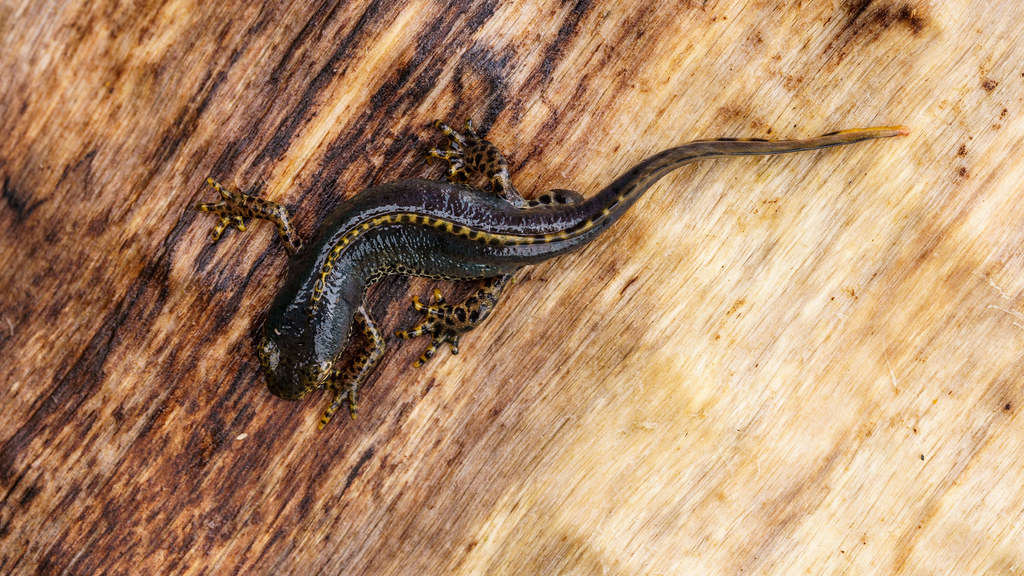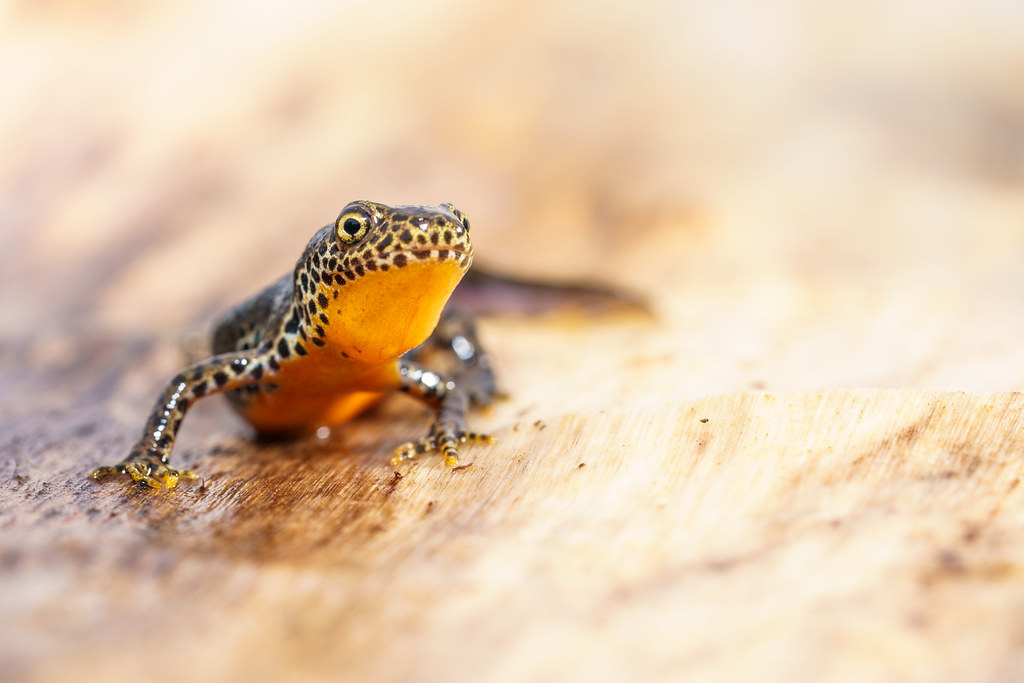#ichthyosaura alpestris
Text

An Alpine newt (Ichthyosaura alpestris) in Italy
by Vittorio Ricci
#alpine newt#salamanders#amphibians#ichthyosaura alpestris#icthyosaura#salamandridae#urodela#amphibia#chordata#wildlife: italy#wildlife: europe
387 notes
·
View notes
Text
Alpine newt (Ichthyosaura alpestris)
Vitosha Mountain, Bulgaria
edit: she's a lady
#leaf-thief oc#ecology#zoology#nature#biology#eastern european#triton#newt#amphibian#bulgaria#biodiversity#alpine newt#ichthyosaura alpestris
299 notes
·
View notes
Photo
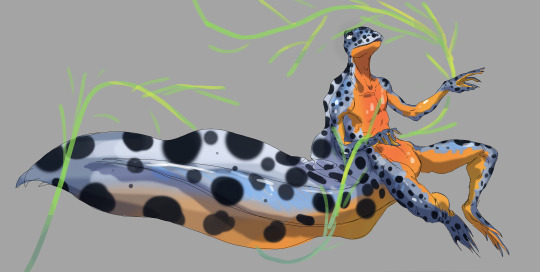
newt
11 notes
·
View notes
Text
Meet Europe's own firebelly
The alpine newt, Ichthyosaura alpestris, is a pretty, colorful European newt, bearing a vibrant red underside. This trait indicates its true phylogenetic relationships, close to Asian fire bellied newts, such as the genus Cynops. I. alpestris is taxonomically subdivided, and may be interpreted as representing a species complex. They reach lengths of up to 12 cm, or under 5 inches, and the females, are around a centimeter, or 1/2 of an inch, longer than the males. These newts are native to continental Europe, but never reached Great Britain or Ireland after the last glacial maximum. Feral populations have now been established in locations outside of their natural range, including Great Britain and Australasia. Within mainland Europe, it is not always obvious, which I. alpestris populations, are indigenous.
I. alpestris prefers vegetated freshwaters, with a pH of 7.5 to 9, amid woodland or forest settings. It can be maintained in a fully aquatic setup, with no access to a land area, although they do have a terrestrial phase, which some wild populations skip. An advantage to keeping them permanently in an aquarium, is greater ease of feeding. Should a terrestrial phase be encouraged, the vivarium should be of a woodland type, with leaf litter, wood, live plants, and a soil substrate. Their natural prey are insects, and other small arthropods. In the aquarium, they will eat defrosted and dried foods of a suitable composition. Neither the air or land temperture should ever exceed 28 degrees centigrade, for any period of time. A much lower temperture, in the range of 14 to 21 degrees, is optimal for their care. These temperate newts will hibernate, at tempertures below 7 degrees.
0 notes
Video
Male alpine newt - Ichthyosaura alpestris by Pieter-Jan Alles
Via Flickr:
Viskot, Linter
0 notes
Text
The Bergmolch - Ichthyosaura alpestris I posted earlier.
Such a lovely lady, look at her cute face.
0 notes
Text
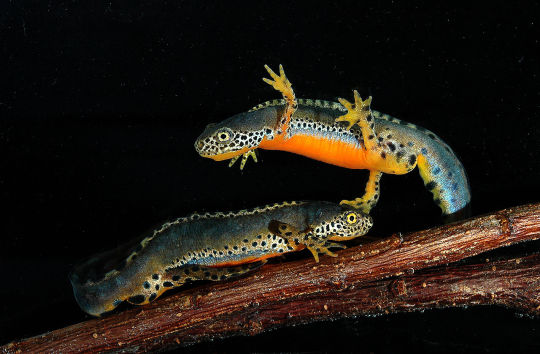
Alpine Newts (Ichthyosaura alpestris), family Salamandridae, found across much of Europe
photograph by Joxerra Aihartza
958 notes
·
View notes
Text

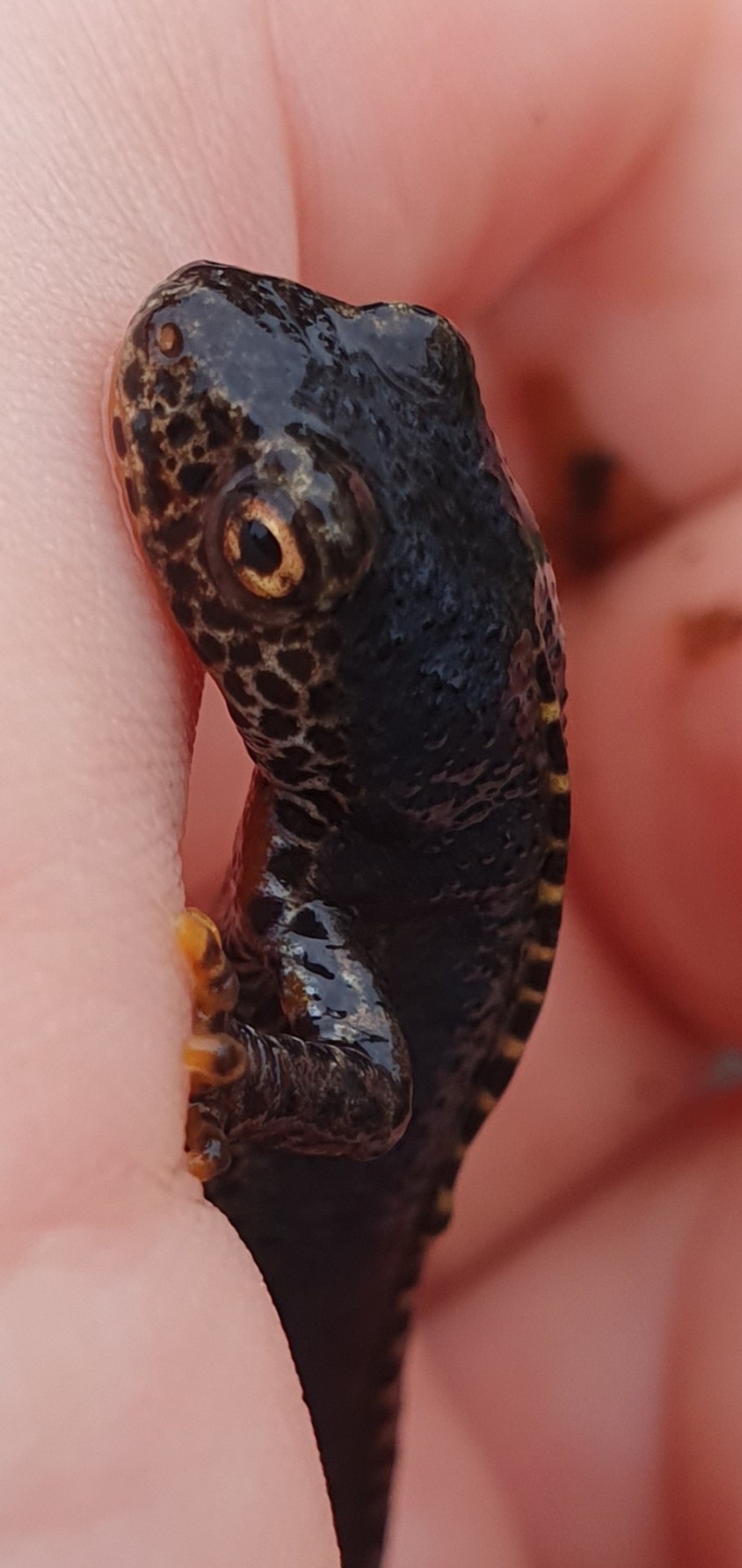

Someone was not happy about getting their picture taken!
This was only one of at least 15 newts that I saw while on a while on a walk through the botanical gardens, some were smooth newts still in their terrestrial colours (brown with darker spots) and these are the beautiful alpine newts. You can differentiate them by their spotless, bright orange bellies.
Did you know in their terrestrial juvenile stage they are called 'efts'?
Ichthyosaura alpestris
02/2024, Germany
10 notes
·
View notes
Text




The heart of the Apuan Alps in Tuscany, Italy, is home to one of the biggest marble mines in the world, with about 160 active quarries in the Massa Carrara and Lucca areas. Since Roman times, creamy-white Carrara marble has been dug out of these mountains. It is the most sought-after marble in the world, and has inspired artists and architects everywhere.
But the Apuan Alps also host an ecosystem that is home to the Italian alpine newt (Ichthyosaura alpestris apuana). In November, Manuel Micheli, a photographer working with the Apuane Libere organisation, stumbled across the newt in Crespina 2, a decommissioned quarry. [...]
“It was incredible to discover such a group,” says Gianluca Briccolani, the co-founder of Apuane Libere, a volunteer organisation formed in 2021 to protect the mountains from environmental degradation, including water contamination caused by the heavy industrialisation of the marble industry.
Cava Crespina 2 lies under Monte Sagro and overlooks the Mediterranean. It was closed in 2014 and became a perfect place for newt reproduction thanks to an underground spring and rainwater filtration in conjunction with the lake’s impermeabilisation, caused by marble dust waste (marmettola).
Since Micheli’s discovery, the newt population has grown – and the scientific and local community has mobilised to protect the newts. Plans to reopen the quarry were halted earlier this month by Unesco and the Apuan Park.
“Last year, we counted at least three dozen newts in different life stages,” says the herpetologist Gabriele Martinucci. “This was a sensational discovery because it means they live in the quarry throughout the entire year. [...]”
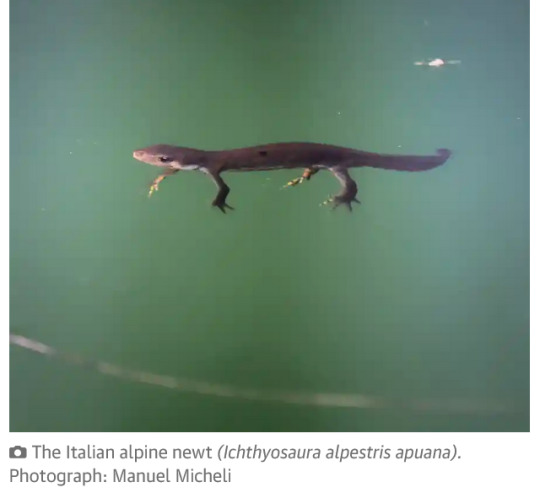
If the Crespina 2 quarry were to reopen, however, the newts there would need to be moved because the excavation would affect the lake where they live, says Apuane Libere.
“We want to do everything to protect the newts,” says Briccolani. “Marble quarrying has nothing to do with art. Entire blocks of marble are crushed to create the calcium carbonate that we find, for example, in our toothpaste. The well-known Carrara marble is no longer used to make the future Davids by Michelangelo, but ends up crumbled or, at most, in the kitchens and bathrooms of a very few rich people.”
It isn’t just newts that are threatened, say campaigners. The Apuan Alps chain hosts about 30% of endemic national flora, including a rare cornflower that grows on the slopes of Mount Borla. But the newts have become “a symbol of the resilience of Apuan biodiversity”, says Andrea Ribolini of the Italian Alpine Club.
Many of those protecting the environment in the area are the children of former quarry workers, including Alberto Grossi, a longstanding activist and group manager for the Apuan Alps of the Legal Intervention Group, an Italian ecological association. [...] Guido Dazzi, a fellow environmentalist, says: “I’m 60 years old and my father was a quarry worker. I come here to monitor whenever I can. [...]”
---
Headline, images, captions, and text by: Alice Pistolesi and Monica Pelliccia. “Brave newt world: the species swimming against the tide of Italian marble.” The Guardian. 23 March 2023. [Some paragraph breaks and contractions added by me.]
77 notes
·
View notes
Text

my babygirl my sweet cheese
haven't played traveller since the summer and i miss my character a lot. this is wobble 😭
they are a kind of newtlike alien called a bwap. it's culturally important for bwap to show off their individual skin colours and markings - on their super humid homeworld they don't wear much clothing, but on other planets or in space they wear custom clothes designed to look exactly like their skin, permeated with water tubes to keep their body constantly soggy.
wobble is currently fleeing from the imperial navy with their spacer crew after being framed for treason. they have turned their spaceship bunk into a sauna, causing significant rust problems. despite being 4 feet tall and physically frail, they love heavy artillery, and use a gravity belt to wield cannons and flamethrowers. they are whiny, quick to anger, and irrepressably curious.

colours inspired by the alpine newt (ichthyosaura alpestris), with a bit of poison dart frog (dendrobates leucomelas) :)
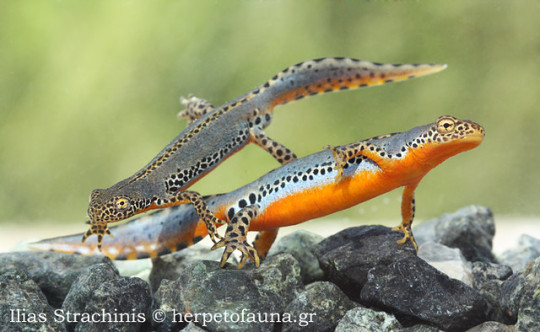

#been neck deep in the new heroforge features for the past few weeks#i wish the head was flatter and less froggy but what can ya do#and the skirt/robe options are not the greatest bc of the nature of modelmaking#they're more of a skirt guy but what can ya do#dnd tag#(i need a better ttrpg tag)
5 notes
·
View notes
Photo

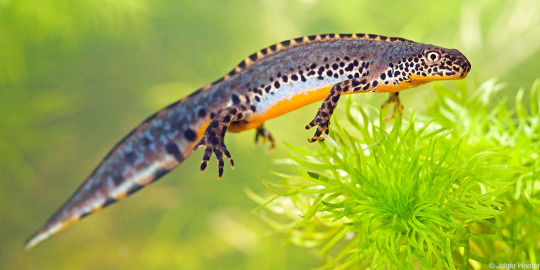


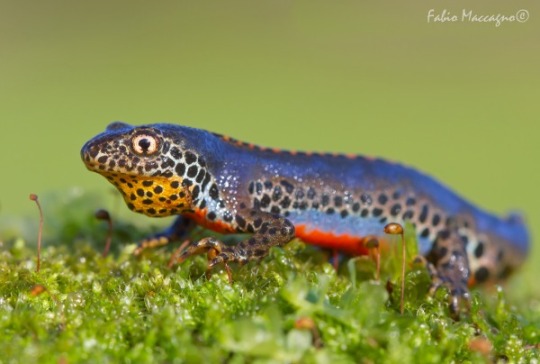

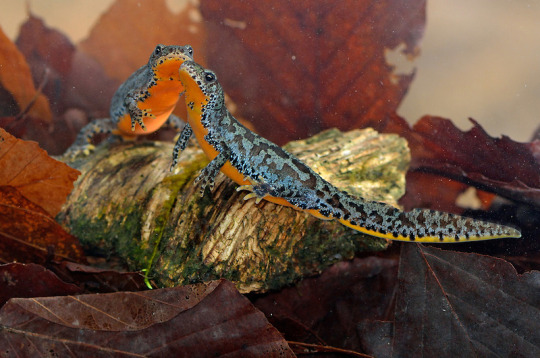



The alpine newt (Ichthyosaura alpestris) is a species of newt native to continental Europe and introduced to Great Britain and New Zealand. Adults measure 2.8–4.7 inches and are usually dark grey to blue on the back and sides, with an orange belly and throat. Males are more conspicuously colored than the drab females, especially during breeding season. Although still relatively common and classified as Least Concern on the IUCN Red List, alpine newt populations are decreasing and have locally gone extinct. The main threats are habitat destruction, pollution and the introduction of fish such as trout into breeding sites.
The alpine newt is a medium-sized, stocky newt species. It reaches 2.8–4.7 inches length in total and a body weight of 1.4–6.4 g. The tail is compressed sideways and half as long or slightly shorter than the rest of the body. During life in water, both sexes develop a tail fin, and males a low (up to 2.5 mm), smooth-edged crest on the back.
The characteristic dark grey to bright blue colour of the back and sides, mainly in males, is strongest during breeding season. This base colour may vary to greenish and is more drab and mottled in females. The belly and throat are orange and only occasionally have dark spots. Males have a white band with black spots and a light blue flash running along the flanks, from the cheeks to the tail. Their crest, during breeding season, is white with regular dark spots.
Alpine newts are usually semiaquatic, spending most of the year (9–10 months) on land and only returning to the water for breeding. The efts [juveniles] are probably terrestrial until they reach sexual maturity. This happens after around three years in males, and four to five years in females. Alpine newts can reach an age of ten years in lowland. At higher altitude, maturity is reached only after 9–11 years, and the newts can grow up to 30 years old.
On land, alpine newts are mainly nocturnal, hiding most of the day and moving and feeding during the night or in the twighlight. Hibernation also usually takes place in terrestrial hiding places. Migration to breeding sites occurs on sufficiently warm (above 5 °C) and humid nights and may be delayed or interrupted for several weeks in unfavourable conditions. The newts can also leave the water again in case of a sudden cold snap. The aquatic phase starts at snow melt, from February in the lowlands to June at higher altitudes, while egg-laying follows a few months later and can continue until August. Some southern populations in Greece and Italy appear to stay aquatic most of the year and hibernate under water.
Alpine newts tend to stay close to their breeding sites and only a small proportion, mainly juvenile efts, disperse to new habitats. A dispersal distance of 2.5 miles has been observed, but such large distances are uncommon. Over short distances, the newts use mainly their smell for navigation, while over long distances, orientation by the night sky, and potentially through magnetoreception are more important.
Paedomorphy, where adults do not metamorphose and instead retain their gills and stay aquatic, is more common in the alpine newt than in other European newts. It is almost exclusively found in the southern part of the range. Paedomorphic adults are more pale in colour than metamorphic ones. Only part of a population is usually paedomorphic, and metamorphosis can follow if the pool dries out. Paedomorphic and metamorphic newts sometimes prefer different prey, but they do interbreed.
Alpine newts are diet generalists, taking mainly different invertebrates as prey. Larvae and adults living in the water eat for example plankton, larvae of insects such as chironomids, crustaceans such as ostracods or amphipods, and terrestrial insects falling on the surface. Amphibian eggs and larvae, including of their own species, are also eaten. Prey on land includes insects, worms, spiders and woodlice.
[1] [2] [3] [4] [5] [6] [7] [8] [9] [10]
292 notes
·
View notes
Photo
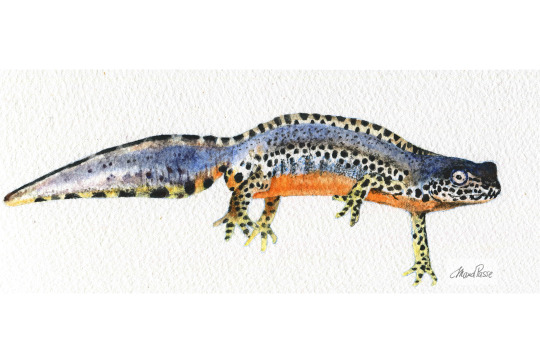
Triton alpestre (Ichthyosaura alpestris)
#naturalistillustration#watercolour#ichthyosaura alpestris#triton#animal#animaldrawing#pencildrawing#wildlife#wild animals#art#Alpes#hautesAlpes
1 note
·
View note
Text

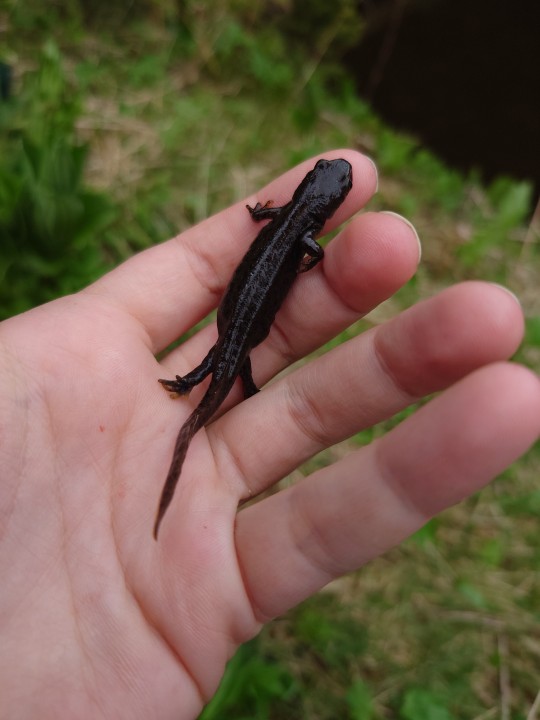
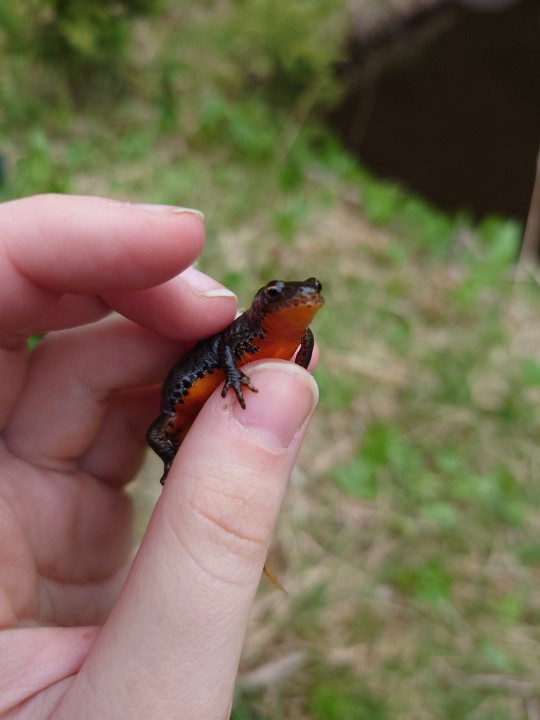
Alpine newt (Ichthyosaura alpestris)
Vitosha Mountain, Bulgaria
#leaf-thief oc#ecology#zoology#nature#biology#eastern european#bulgaria#biodiversity#amphibian#newt#alpine newt#ichthyosaura alpestris
94 notes
·
View notes
Text
The Creature Awaits #129:
Each week I plan to feature an amazing creature, admiring God's fantastic artistry. Hopefully it’ll brighten someone’s day to see something new and interesting if they haven’t seen it before. : )

(Beautiful photographs taken by Lottie (top) and Miltos Gikas (bottom) - (CC0 1.0) and (CC BY 2.0), respectively.)
The Alpine Newt
Scientific Name: Ichthyosaura alpestris
Region: Primarily central Continental Europe, including high up in the Alps it's named after
Size: 2.8" to 4.7" (7cm - 12cm) long, including the tail
Interesting Note: Interestingly, this gorgeous amphibian thrives at surprisingly cold temperatures and high altitudes. Though they can technically survive in temperatures up around 80°F (26.7°C), the warmest temperature they ever need is a bit above 41°F (5°C) during their "aquatic phase" where they return to the water annually to breed and lay their eggs at the start of snowmelt (February in low altitudes, June in high ones). They have a much longer potential lifespan at higher altitudes as well: increasing from up to 10 years, to up to 30.
#creatureawaits#alpine newt#european animals#beautiful amphibians#cold climate amphibians#Ichthyosaura alpestris#pretty newt#hide
0 notes
Photo

alpine newt (Ichthyosaura alpestris) by ernstpluess
0 notes
Video
Male alpine newt - Ichthyosaura alpestris by Pieter-Jan Alles
Via Flickr:
Viskot, Linter
#Male#alpine#newt#Ichthyosaura#alpestris#alpine newt#Ichthyosaura alpestris#Wildlife#Nature#Animal#Sony#ILCE-7RM3#FE#90mm#F2.8#Macro#G#OSS#Sony ILCE-7RM3#FE 90mm F2.8 Macro G OSS#flickr
1 note
·
View note
